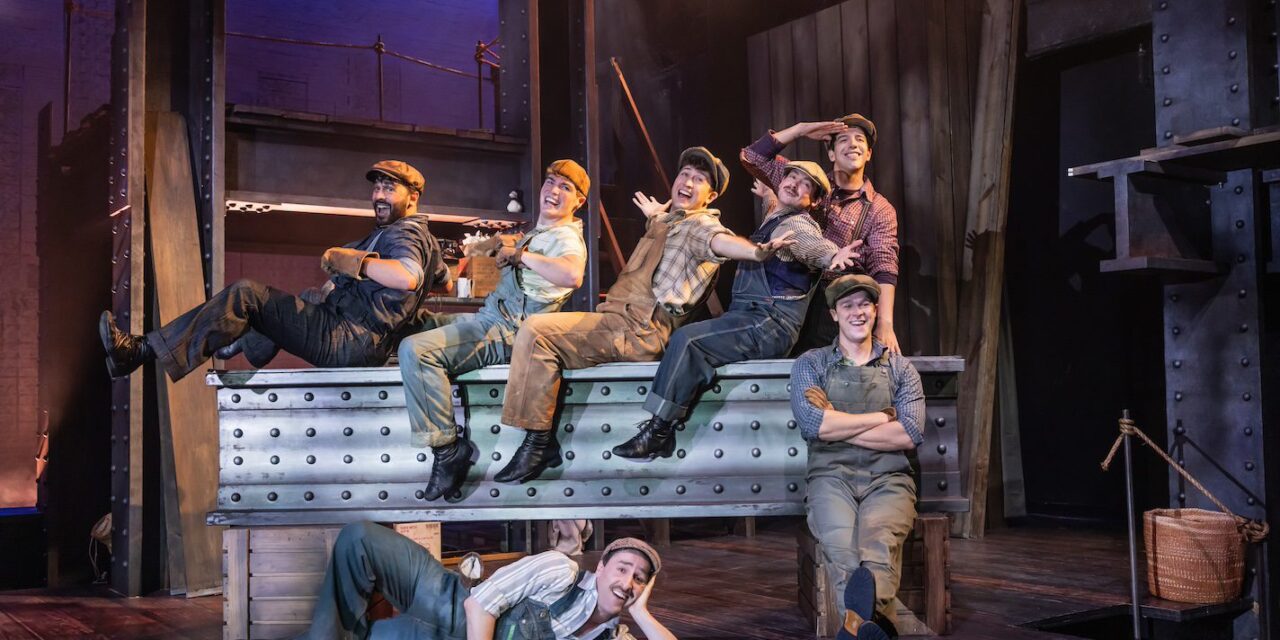Theater Review by Samuel L. Leiter . . .
Summertime, and the pickings are measly. At least that’s the case with two new Off-Broadway musicals I had the displeasure of seeing over the past two weeks. Last week’s debacle was From Here, which recounts the horrific 2016 slaughter of 49 people at Orlando’s gay nightclub, Pulse, through the lens of a gay rom-com. This week’s is Empire: The Musical, which premiered early in 2016 at Los Angeles’s La Mirada Theatre for the Performing Arts in a significantly different production, with a script to which many changes—including character names—have been made.
Now at New World Stages, it’s an ambitious attempt to tell the remarkable story of the building of New York’s 102-story Empire State Building (ESB), for many decades the world’s tallest building. Amazingly, it went up in a year and 45 days—between 1930 and 1931. (It’s now New York’s seventh tallest and the world’s 54th tallest.) I know apartment houses that took longer to complete.
While the book, music, and lyrics by Caroline Sherman and Robert Hull are built on a potentially strong foundation, the structure is too flimsy to support all the weight brought to bear on it. A combination of fact and fiction (only a few real people are represented), it presents its narrative through half a dozen subplots, the principal one being the travails experienced in the project by its foremost cheerleader, former New York Governor Al Smith (Paul Salvatoriello), after whom the building was originally going to be named, and his trusty Gal Friday, Frances Belle “Wally” Wolodsky (Kaitlin Davidson).

The book, whose overarching theme is about the need for hope and perseverance to achieve your dreams, sketches in some of the details that went into the construction of the edifice. It was erected at Fifth Avenue and 34th Street, previously the site of the Waldorf-Astoria Hotel, which re-opened on Park Avenue (at East 50th Street) in 1931. A significant subplot dramatizes the opposition to its building by the Fifth Avenue Association, headed by the snooty, English-accented (of course), representative of the upper crust, Mrs. Janet Arthur (Alexandra Frohlinger), who believes its presence will diminish Fifth Avenue’s famed cachet of architectural refinement.
However, the subplot that incites the action concerns a Brooklyn family in 1976, part of the Mohawk community that, along with numerous immigrant workers, helped build the ESB. The show seeks to honor the Mohawks’ culture, including some lines and lyrics being in the indigenous tongue. Their repute stemmed from their fearless work on the highest beams, where they were known as the “sky boys” or “skywalkers,” although you won’t hear either word in the show. The family is moving away and Sylvie Lee (Julia Louise Hosack, understudying for Jessica Ranville at the preview I attended)—daughter of a Mohawk woman and a Polish poet/ironworker father who died while working on the ESB—chooses this moment to discover what she calls “My Story.” This happens as she’s going through family artifacts and is visited by Wally, referred to for no discernible reason as “Aunt Wally,” looking just as she would have in 1930.
Without much ado (or explanation from the writers) Sylvie and Wally step into the story of the ESB’s construction. As written, none of this makes sense, but you must go with the flow, even when Sylvie finds herself interviewing her own late father, Joe Pakulski (Devin Cortez), whom she never knew. Soon we get entangled in the stories of the skyscraper’s physical construction (lots of data—sung and spoken—about materials and the like), and the necessity of getting it built by a legal deadline. Just as important, we learn about the lives of the various characters, several of them immigrants with stagey accents.
The show thus slogs along for two and a half plodding hours to depict Irish worker Ethan (J Savage) O’Dowd, and his wife, Emily (Morgan Cowling), who doesn’t want him on the high beams but only in “the interior”; the chemically inert romance of Wally and architect Charles Kinney (Albert Guerzon); the completely implausible affair of Joe and ironworker Rudy Shaw (Kiana Kabeary), a Mohawk woman who passes herself off as a man because only men were hired for construction work; Joe’s accidental death and the speculation it was an insurance-inspired suicide (actually, despite the conditions, only five deaths were documented during the project); the maneuverings of Smith, entrepreneur John J. Raskob (Howard Kaye)—an actual person—and Charles, with Wally’s assistance, in the face of Mayor Jimmy Walker’s (Cortez, again) threats; the incipient racism of the immigrants toward the Mohawks, and so forth.

Empire at first seems to have the impressive look needed for a tale about a skyscraper’s construction. Walt Spangler’s set of faux metal beams in mid-construction allows for multiple locales to be suggested here and there, but, despite its large scale for an Off-Broadway show, it gradually grows tiresome as very little on it changes. A huge, dirty window hanging overhead offers a modicum of variety when it shifts position, although it’s not clear why it’s even there; it’s surely not part of the new building, so where’d it come from?
Meanwhile, the cyclorama, which might have been used for exciting projections to share the building’s progress, is mostly ignored, a crucial lapse. Digital images are intrinsic to today’s theater design, so why were they not incorporated here, where they’re so desperately needed? Rayne herself alludes to Lewis Hine’s famous photos of the building and its workers, which were taken from the most precarious sites during construction. What we do get on that dull cyclorama, however, despite Jamie Roderick’s otherwise acceptable lighting, are too many shadows. (After writing this I discovered that one of the most distinctive contributions of the LA premiere was Brad Peterson’s projections, seen on an IMAX screen, although Hine’s photos don’t appear to have been used.)
For all the machismo associated with the creation of the ESB, Empire is determined to give it a feminist twist, even having Joe and Rudy’s granddaughter, Lorayne (Kabeary, again), who insists on being called Rayne, declare she wants to become a steelworker. Wally, perhaps a bit too fashionably dressed by Tina McCartney—would a New York politician’s female aide be dressed in a rust-colored, Hollywood-style slack suit in 1931?—comes off as the person most responsible for carrying the project to completion.
Cady Huffman, best known as a Tony-winning musical theater performer (The Producers) but with a rather extensive resume offstage as well, directs a 17-member ensemble—large for Off-Broadway, and with many actors doubling—but is unable to elicit more than superficial performances from an energetic but, with two exceptions, two-dimensional company, most of whom dance or sing better than they act. On the other hand, you need to be a Meryl Streep or Anthony Hopkins to make Sherman and Hull’s dialogue work. There’s not much you can do when someone says “Some say the Al Smith project is capitalist folly,” to which the reply is, “This is not a folly,” while a third party adds, “I love the Follies. I’m seeing them this weekend.”

Kaitlin Davidson’s Wally, who is sometimes reminiscent of a young Bebe Neuwirth, is the standout, both musically and histrionically. She uses a reasonably convincing Brooklyn accent but someone should tell her “tukas” should be “tuchus,” with a phlegmy “ch.” Also, a 1930s Brooklynite would say “pajahmas,” not “pajaamas.” Paul Salvatoriello, capturing a touch of Al Smith’s old-time vaudeville aura, also acquits himself well. At the other end of the spectrum are Alexandra Frohlinger’s bizarrely cartoonish society lady, Mrs. Arthur, and Albert Guerzon’s Charles Kinney, played with an often incomprehensible, marbles-in-his-mouth British accent. He’s as egregiously miscast in the romantic leading man’s role as would be Jim Parsons as the hero of The Bridges of Madison County.
Few of the melodically unmemorable songs, barely any of them advancing the plot, break out of familiar stereotypes, but they sometimes manage to capture a bit of the period flavor. One, “Moxie,” sung by Smith, Raskob, and Charles, hints vaguely at the far superior “Little Tin Box” in Fiorello!; it’s well enough performed to ignore its weaknesses. Lorna Ventura’s choreography sometimes suggests, without equaling, the explosive moves of Newsies. It’s energetic but familiar.
“Lookahee,” a song and dance in which the laborers try to catch female eyes, is staged near a steel beam, but the scenic unit sits on the floor, with the men arranged on the beam as per Hine’s photographs. If only that beam were raised and the dancers, even if using wires, allowed to carry on with a sense of real danger, the number might have been exhilarating. Nowhere, however, does Empire create the illusion of seeing these metal workers doing their riveting work at presumably perilous heights, which lighting and projections could have achieved.
But that’s the trouble with Empire: The Musical. It lacks the kind of conceptual imagination that would let it, like its namesake, scrape the sky. Instead, it remains stolidly grounded in the schist of unadventurous conventionality.
Empire: The Musical. Through September 22 at New World Stages (340 West 50th Street, between Eighth and Ninth Avenues). www.empirethemusical.com
Photos: Matthew Murphy


